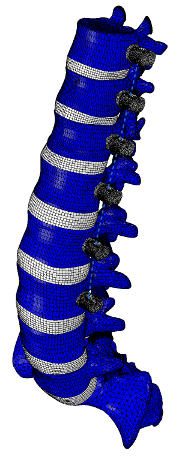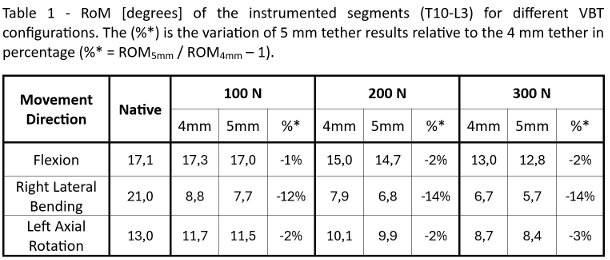German Congress of Orthopaedics and Traumatology (DKOU 2025)
Deutscher Kongress für Orthopädie und Unfallchirurgie 2025 (DKOU 2025)
Vertebral body tethering configurations: A finite element study on tether breakage risk and spinal biomechanics
2Federal University of Santa Catarina (UFSC), Department of Mechanical Engineering, Florianópolis, Brasilien
3BG Klinikum Bergmannstrost Halle, Department of Trauma and Reconstructive Surgery, Halle (Saale), Deutschland
4Federal University of Santa Maria (UFSM), Department of Mechanical Engineering, Santa Maria, Brasilien
Text
Objectives and questions: Vertebral Body Tethering (VBT) presents a dynamic alternative to spinal fusion in scoliosis correction. However, tether breakage remains a significant clinical issue [1]. This study employs a validated finite element (FE) model of the spine to evaluate tether configurations with 4 mm and 5 mm diameters in the thoracolumbar spine. The tradeoff between preservation of the range of motion (RoM) and impact on tether tension and overall spinal biomechanics was investigated.
Material and methods: A validated FE model of the thoracolumbar spine (T10-S1) (Figure 1 [Fig. 1]), calibrated against experimental data from a cadaveric study [2], [3], was prepared to simulate VBT configurations, varying the diameter and tether pre-tension: with 4 and 5 mm tether diameters implanted in the left side of T10-L3 segment, and pre-tensions of 100 N, 200 N, and 300 N. Moment loading conditions of 8 Nm were applied in the anatomical planes — flexion-extension, lateral bending (LB), and axial rotation (AR) — to assess the RoM, forces, and tension on the tether. Breakage risk was evaluated through comparative tension analysis across configurations.
Figure 1: Computational model of thoracolumbar spine segment instrument with VBT on the left side between T10-L3. The dotted blue line represents the tether connecting the implanted screws.
Results: The FE results are presented for different pre-tensions on the tether itself and the tether diameter. Flexion, LB-Right, and AR-Left directions were analyzed for the instrumented segments. In flexion, the RoM decreased by 1–2% with the 5mm tether (Table 1 [Tab. 1]), while LB-Right and AR-Left exhibited reductions of up to 14% and 3%, respectively. The mean tether forces increased for the 5 mm configuration by 2–4% higher across the analyzed directions), while the peak tether stresses were reduced by approximately 34–35% under each loading scenario (Table 2 [Tab. 2]).
Discussion and conclusions: Increasing the tether diameter from 4mm to 5mm in VBT leads to a substantial reduction in tether stress — by over 30% — despite minor increases in applied force and a slight decrease in RoM. This trade-off suggests that a 5mm tether may offer a safer biomechanical profile by reducing the risk of tether breakage while preserving the spinal mobility close to the traditional tether with a 4 mm diameter. These FE findings support the potential of larger-diameter tethers in optimizing clinical outcomes for scoliosis correction through VBT. Further validation in clinical trials is needed to confirm these biomechanical advantages over the long term.
References
[1] Baroncini A, Trobisch P, Eschweiler J, Migliorini F. Analysis of the risk factors for early tether breakage following vertebral body tethering in adolescent idiopathic scoliosis. Eur Spine J. 2022 Sep;31(9):2348-54. DOI: 10.1007/s00586-022-07231-w[2] Nicolini LF, Kobbe P, Seggewiß J, Greven J, Ribeiro M, Beckmann A, Da Paz S, Eschweiler J, Prescher A, Markert B, Stoffel M, Hildebrand F, Trobisch PD. Motion preservation surgery for scoliosis with a vertebral body tethering system: a biomechanical study. Eur Spine J. 2022 Apr;31(4):1013-21. DOI: 10.1007/s00586-021-07035-4
[3] Nicolini LF, Beckmann A, Laubach M, Hildebrand F, Kobbe P, Mello Roesler CR, Fancello EA, Markert B, Stoffel M. An experimental-numerical method for the calibration of finite element models of the lumbar spine. Med Eng Phys. 2022 Sep;107:103854. DOI: 10.1016/j.medengphy.2022.103854






